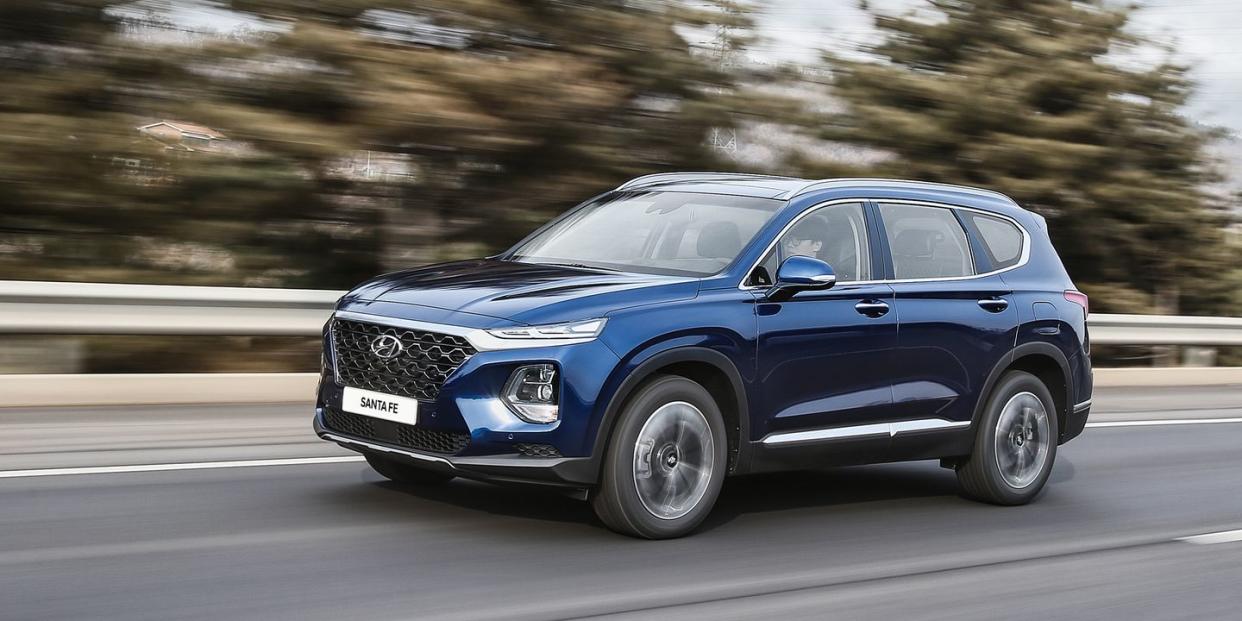2019 Hyundai Santa Fe: Bolder Looks and an Optional Diesel [Update: The Diesel Is Dead]

UPDATE 12/17/18: Hyundai has canceled plans for the Santa Fe's optional 2.2-liter four-cylinder turbo-diesel engine, citing a lack of consumer demand and stable fuel prices. This also means that the diesel model's planned third row of seats won't be part of the lineup, leaving the new, larger Palisade, which replaces the outgoing Santa Fe XL, as Hyundai's sole three-row SUV offering.
Nearly two decades after the Hyundai Santa Fe first went on sale, the Korean automaker has taken the wraps off of the all-new fourth-generation model. As part of the switchover, short-wheelbase models drop the Sport suffix for the new generation, while the current-generation, long-wheelbase, three-row model will wear the Santa Fe XL moniker for the 2019 model year.
The 2019 Hyundai Santa Fe is redesigned from the ground up. Not that you wouldn't notice, as its square-jawed styling is revolutionary next to today's comparatively staid versions. The new model incorporates the automaker's latest design cues, including a pair of thin, LED daytime running lights at the top corners of the front end. LED headlights are clustered below that. With more upright body panels, larger rear quarter glass, and a 2.8-inch growth spurt in overall length, the Santa Fe looks almost French and stands out next to more conservatively styled competitors such as the Ford Edge and the Kia Sorento.

Motivating the new Santa Fe is a standard 185-hp 2.4-liter inline-four. Those in search of additional oomph can opt for a turbocharged 2.0-liter inline-four with approximately 232 horses. Both engines couple with a Hyundai-built eight-speed automatic transmission to put power to the ground.
A wheelbase that has been stretched 2.6 inches relative to the outgoing Santa Fe Sport sees front-seat legroom swell by a whopping 2.8 inches, while second-row legroom grows by an inch. Cargo volume grows modestly from 35 cubic feet to 37 cubes.
Accompanying the Santa Fe's additional interior space is an all-new dashboard design that incorporates a tablet-style infotainment system and an available digital gauge cluster. All trim levels receive Apple CarPlay and Android Auto capability, while a navigation system and a head-up display are optional. Safety features such as automatic high-beam headlights, a blind-spot monitoring system, adaptive cruise control, and lane-keeping assist can also be added to the new Santa Fe, as can a new rear-seat occupant alert system and a safe-exit assist function.

The occupant-alert system reminds the driver to check the rear seat before exiting the vehicle, as in many modern General Motors vehicles, among others. However, Hyundai goes one step further by equipping the Santa Fe with interior motion sensors, and the vehicle will honk the horn, flash the lights, or send a text message if interior motion is detected after the driver exits the vehicle. Meanwhile, safe-exit assist prevents the driver or passengers from opening the door if another object is approaching the Santa Fe from the rear. When triggered, safe-exit assist sends an audible alert throughout the cabin and a visual alert to the gauge-cluster screen and keeps the doors locked.
The 2019 Hyundai Santa Fe starts at $26,480 for the front-wheel-drive SE 2.4 and tops out with the $39,780 all-wheel-drive Ultimate 2.0T.
You Might Also Like
